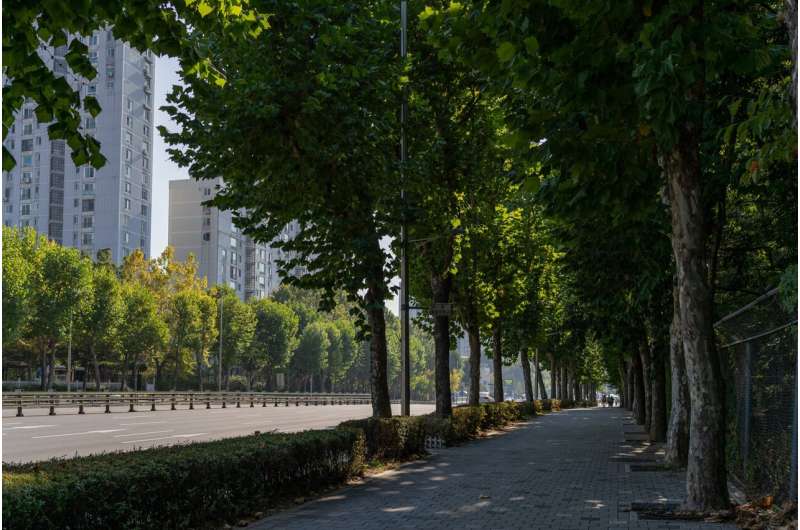This article has been reviewed according to Science X's editorial process and policies. Editors have highlighted the following attributes while ensuring the content's credibility:
fact-checked
trusted source
proofread
Mapping heart health: AI illuminates neighborhood impact on well-being

Is the view from your doorstep mostly trees and sky or buildings and grass? The answer could influence your cardiovascular health, according to a study presented at the American College of Cardiology's Annual Scientific Session. Using an analysis of Google Street View images powered by machine learning, researchers found people living in surroundings rich in sidewalks, trees and clear sky saw a significantly lower risk of major adverse cardiac events.
"A lot of research has shown that environmental factors strongly affect our health. If we can find a way to stratify this risk and provide interventions before cardiovascular events happen, then we could save a lot of lives," said Zhuo Chen, Ph.D., a postdoctoral researcher at Case Western Reserve University and University Hospitals Health System in Cleveland and the study's lead author.
"Our study shows that with advanced computer vision algorithms and AI, we now have the ability to quantify the built environment more effectively and efficiently. If we can assess the individual's risk at a granular level, we could provide more personalized interventions."
The study is part of a growing body of research investigating how greenspace and the built environment influences cardiovascular risk. Previous studies have used a variety of approaches to quantify environmental features, with mixed results.
By combining Google Street View images with robust segmentation methods for analyzing "vertical greenspace"—the view along the skyline and not only on the ground—this study offers a more nuanced and granular perspective on the environment at the level of individual streets rather than averaging across entire counties or ZIP codes.
The researchers used a machine learning algorithm trained to distinguish between trees, grass, sky, sidewalks, buildings and roads to analyze Google Street View images of the residences of nearly 50,000 study participants. Participants were part of a program that provides free and low-cost coronary artery calcium tests (a non-invasive screening method to assess heart disease risk), mostly in northeastern Ohio.
Over a median follow-up period of about 27 months, approximately 2,000 of the patients had experienced a major adverse cardiovascular event, such as a heart attack, stroke or death from heart disease. By analyzing participants' built environment, researchers found that people living in areas with more sidewalks were 9% less likely to suffer major cardiac events than people living in places with fewer or no sidewalks.
In addition, people living in places that scored highly for vertical greenspace—trees and clear sky—were 5% less likely to suffer these events than people in areas that scored low for this metric. These associations were independent from each other.
To account for other factors known to influence heart health, the researchers adjusted the models for age, race, sex, social vulnerability, median household income, fine particle air pollution, noise and cardiovascular risk factors, such as high blood pressure, high cholesterol and diabetes.
"The method and the data source that we're using here is cheap, open source and publicly available," Chen said. "It can assess anywhere there are Google Street View cars on the road and really provide a refined metric of the environment."
The results showed no association between the presence of grass and the risk of cardiovascular events, further bolstering the results of previous studies that found a closer association between trees and cardiovascular health than just grass.
However, Chen said that trees alone were not found to have an association with cardiovascular outcomes. Rather, it is the combination of trees and clear sky that together appeared to be a better indicator of vertical greenspace. To refine this metric, the researchers incorporated depth information into the machine learning algorithm.
The study design did not allow for the determination of a causal relationship between environmental features and heart disease, Chen said. It also did not include data on residents' physical activity or travel behaviors, limiting the ability of researchers to directly examine the mechanisms linking greenspace, walkability and cardiovascular outcomes. In addition, researchers said the cohort consisted mostly of individuals in northeast Ohio, which may limit generalizability of the findings to other areas.
Nevertheless, by refining methods for assessing environmental features at scale, Chen said the work can offer useful insights for addressing an important public health issue at the intersection of environment and personal health.
"It doesn't necessarily mean that if we plant more trees or build more sidewalks, we'll reduce cardiovascular risk," Chen said. "But it still gives us preliminary suggestions and indicators that can help us become aware of ways to change behaviors or neighborhood planning in the future to [potentially] lower cardiovascular risk."
More information: Chen will present the study, "Residential Vertical Greenspace and Sidewalks Impacts on Cardiovascular Risk: Insights from Deep Learning-Enhanced Google Street View," on Sunday, April 7, 2024.





















